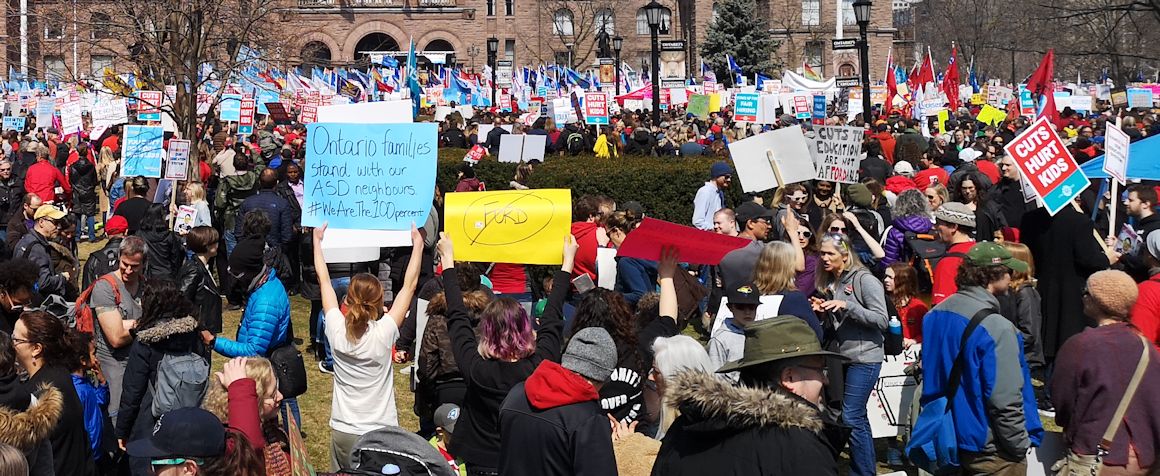PV Ontario Bureau
On November 14, the Campaign for Public Education (CPE) launched a province- wide campaign to eliminate the repairs and maintenance backlog in Ontario’s schools. CPE was founded in 2002 to coordinate efforts of parent, teacher, education worker and ethno-racial organizations in campaigning for needs-based funding for public education.
The “Fix Our Schools” campaign builds on a comprehensive study of Ontario’s school repairs and maintenance backlog, undertaken by economist Hugh Mackenzie. On November 14 Mackenzie will release his report, which will detail how the next Ontario government could eliminate the school repairs and maintenance problem.
The alarming state of disrepair in Ontario’s schools was highlighted in a 2015 Ontario’s Auditor-General’s report which detailed chronic government underfunding to the provinces 74 school boards:
“An independent assessment calculated that the Ministry of Education needs $1.4 billion a year to maintain schools in a state of good repair. However, actual funding in the last five years has ranged from $150 million to $500 million.”
In the three years between 2011 and 2014, provincial funding to school boards for school renewal was only $150 million per year – roughly one-tenth of what the Auditor’s Report indicated was needed.
Because of the serious inadequacy of the government’s public education funding formula, the choice for Ontario’s school boards has most often been to defer maintenance expenditures and renewal investments so as to protect school programs. This growing crisis was highlighted in the December 2002 report of the Education Equality Task Force (the Rozanski Report). That re- port identified a deferred maintenance backlog estimated at $5.6 billion and growing.
Despite several rounds of special funding aimed at school facility renewal over the ensuing 15 years, the backlog, as measured by the Ministry itself, has grown consistently, and is now well over $15 billion. Even this figure is an understatement. Of the 4,636 schools in the detailed database released in 2017, no data on renewal needs was reported for 346, of which 284 schools were shown as not having been assessed.
Parents, students, teachers and education workers all know what needs to be done.
The Fix Our Schools campaign is a province-wide effort to force the Ontario government to ad- dress the immediate problem and take steps to ensure that it does not recur.
The campaign will press for 5 main objectives:
- The education funding formula must be enhanced to provide a realistic level of funding for on- going school renewal. Taking the mid-point of the 2% to 4% range of ongoing renewal investment needed, that would require an increase in school renewal funding from the current temporary level of $1 billion a year to an ongoing funding level of $1.7 billion per year, increasing as the replacement value of school buildings increases.
- A separate stream of capital funding must be created to re- place the 346 school buildings across the province determined to be too expensive to repair as of the most recent review cycle. That will require a one-time capital injection estimated at $3.9 billion for those 346 schools. Each year, more and more schools move across the line that divides those that require substantial renewal investments from those that are prohibitively expensive to repair.
- Capital funding should be opened up to enable boards to develop new schools in growing areas under their jurisdiction, without reference to the occupancy status of distant schools. To support that additional in- vestment, school boards should be required to levy development charges to defray a portion of the cost of both land and buildings in growing areas.
- To mitigate against school conditions continuing to deteriorate in the future, the funding formula for school operations and maintenance should be enhanced, and its fundamentals reconsidered.
- The general level of funding for school operations and maintenance should be established based on a careful analysis of community-based data on what is required to maintain schools as safe and secure public-use facilities. As a starting point, total operations and maintenance funding should be increased by 8.7% to match the APPA North American Average.
- The formula should recognize explicitly the underlying drivers of differences in operating costs for schools in the province, including:
- Labour costs in the community
- Heating costs and climate
- The age and design of school buildings – a formula that recognizes building age only up to 20 years is not realistic
- One size does not fit all; equality does not achieve equity when needs and costs are different.
-
- The formula should take explicit account of school space needs for specialized programs such as music and art, school breakfast and lunch programs and special education programming as well as community use of school facilities.
- Expected utilization should not be used as a weapon to force school boards to close schools; utilization expectations should be based on a broadly-based view of the role of the school in the community, and should take into account the implications for student access and commute times of forcing underutilized schools to close.
- The provincial government should establish an explicit and quantifiable standard of good repair for school facilities in the province, require that school boards maintain their facilities to that standard and ensure that funding provided to school boards is sufficient to support that standard. For more information about the Fix Our Schools campaign, please visit campaignforpubliceducation.ca




